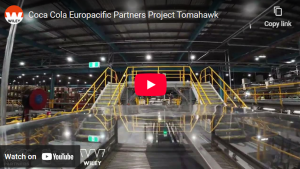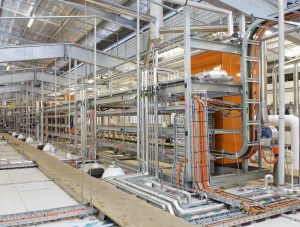
- Industry Type: Industrial Manufacturing, Food Processing
- Author: Andrew Newby
- Service Area: Advice
- Date: 26 Jul 2011
MAKING MOLEHILLS OUT OF MOUNTAINS
Managing complex projects and keeping up with the latest innovative processing techniques and technology can be challenging for managers. If you are upgrading or building a new food facility, managing your risk and early planning can turn challenges into opportunities.
Risky Business
Projects, defined by their temporary nature as having a start and finish date, carry different risks to your business than everyday business activities.
What are the major risks to your business from projects and how do you protect yourself against them?
- Cost—final project cost exceeding the budget.
- Time—milestone or project completion dates are later than planned.
- Quality—quality does not meet specified standards.
- Safety—personal injury to your employees or contractor’s employees.
- Operational—completed project not doing what is was designed to do.
- Production—interruption of existing production during construction.
Project managers use a myriad of tools and techniques to manage project risks, however if they are not continuously doing projects, the chances are they will not be familiar with these techniques and will not have the systems to support them.
Contracts
Owners look to contracts to protect themselves and their business from these risks. To manage time risk, they may develop a contract with liquidated damages to recover financial compensation if dates are not met. To manage cost risk, they may use a lump sum contract so the maximum cost is known at the beginning, providing protection from risks such as unexpected variations.
The contract will not save the owner if the project delivery approach does not match the type of the project. Project delivery approach is the methodology used to complete the project and includes all aspects of initial advice, ongoing design, approvals, tendering, contracting, time scheduling, cost management and commissioning.
Simple projects can be completed with a simple approach and straightforward contractual documentation. Consider the example of designing and building a platform.
If the purpose of the platform is for storage of cardboard boxes in a factory environment, considerations would be safety, access and structural adequacy. There is very little interface between the operations and the construction of the platform. In this example, the scope of work can be easily documented in drawings and specifications. A well-executed, traditional lump sum contract can be an appropriate project delivery approach.
In contrast, consider a platform in a processing facility where the use of the platform may involve a new process or technology which has a high interface with existing facility operations. The platform must be completed within a very short time period and parts of the work completed to fit in with production schedules.
Considerations in this case would include:
- Minimising disruption to existing operations during construction
- Layout and support of pipe work and other services
- Access around equipment and services
- Platform height and size to suit process
- Heavy structural loads
- Meeting specific food regulatory requirements
In this type of complex project, it is difficult for the traditional lump sum delivery approach to provide adequate risk protection because the contract, methodology and nature of the project are not aligned.
Where a contractor has submitted a low tender bid in order to win the project, the contractor will act to protect their own interests. For example, the equipment supplier has just completed the final design, based on new production data from your operations staff and they advise you that the equipment to be positioned on the platform will actually weigh more than first expected.
The platform design is then inadequate and additional money is required to update the design. A cooperative arrangement between your operational staff and the contractor for work access and cut-in of services has not been as successful as predicted, as it could not be adequately specified or managed. These events lead to variations or change orders, resulting in increased costs and late milestone or completion dates.
This is just one simplified example that can occur within the food and beverage industry, where projects are often not simple by nature.
Procurement
The role of Procurement within your company is to purchase a specified service or items at the lowest cost. This approach can be suited to where the purchase is clearly described and there are multiple suppliers readily available.
On complex processing projects, the purchase cannot be clearly described without the input of expertise from equipment suppliers, contractors and internal production staff.
Tendering
The traditional tender system will always drive a contractor to provide the minimum content to meet compliance. How this minimum content is delivered can have severe long term financial and operational implications. Early Contractor Involvement (ECI) allows the input of a contractor experienced with food and beverage facilities, rather than working to designs that do not incorporate the multitude of complexities involved in building/process integration.
Some may argue tighter contracts are the sole answer but a contract cannot make a bad contractor good. Traditionally, contracts have been written in adversarial formats to reflect a traditional tender approach. As projects become complex, modern partnering contracts take a ‘partnering’ or ‘agency’ approach. Any lawyer asked to comment on a contract should be fully briefed as to the intent of the client/contractor relationship or they will often assume the conventional adversarial approach. This can destroy much of the good intention in the evolution of the project approach.
A partnering approach
With new technologies emerging, a specialised partnering approach to the engineering and construction facets of a project is often critical, as a large number of consultants may be involved. An understanding of these areas of specialisation and their extent of work is important to avoid variations caused by gaps between consultants’ services.
This may be the largest capital investment your company makes for a long time. The ultimate goal is to follow a partnering, risk-managed approach. With technical food and beverage projects, it is valuable to draw on experience. It is essential to work with internal and external people you respect and trust.
This approach ensures the owner more input on the major decisions and greater control over the timing and budget. The results at the end of the project should be no surprise, but should be aligned with the expectations set at the very beginning of the process.
Strong relationships and communication, the most suited contract and project delivery method and talented partnering teams—the success of your project depends on it!
About the author
Andrew Newby is the Business Development Director at Wiley and can be contacted on 1300 385 988 or email connect@wiley.com.au.
Further Information
A detailed Contract Comparison Table is located here.
We have evaluated contract types in terms of how well they deliver on key project success factors to assist you in choosing the right contract for your next project.
This article was published in Food & Drink Business Magazine.
Download to read full article
To read this document you will need Adobe Reader


